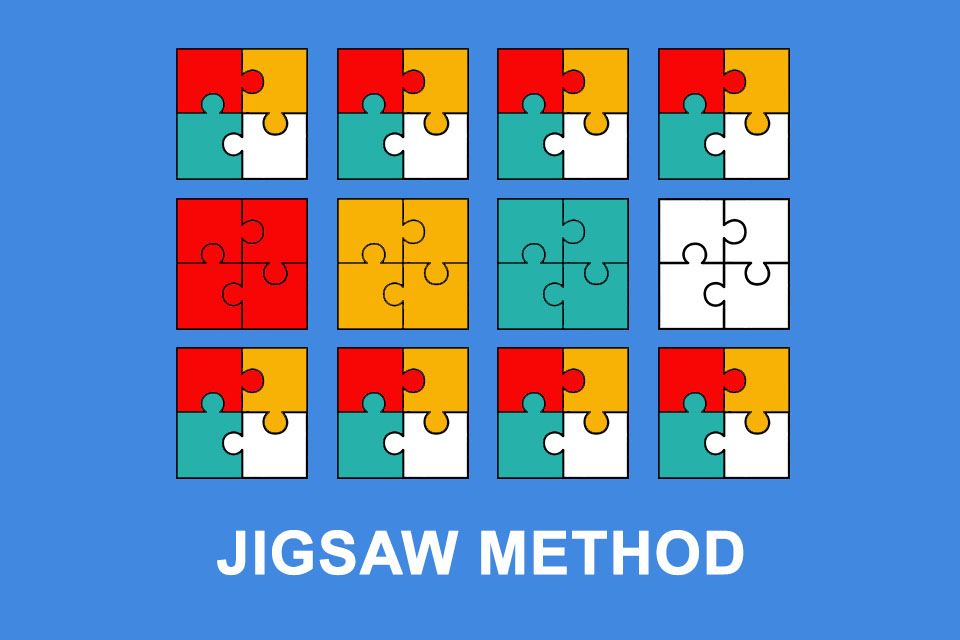What is the Jigsaw Method?
Jigsaw Method – a cooperative group puzzle
The Jigsaw Method is a cooperative learning technique developed in 1971 by Elliot Aronson and students at the University of Texas at Austin, USA and later presented in the book “Cooperation in the Classroom”¹, among others. The aim was to promote interdependence and cooperation between students while improving their understanding of learning content.
Elliot Aronson, a social psychologist, developed the Jigsaw Method to address prejudice and discrimination in schools.² The method is not an abstract social psychological framework developed to explain relationships between groups or individuals, but a strategy developed in response to an immediate need for social action. Aronson believed that by fostering positive relationships and breaking down stereotypes, students would develop greater empathy and respect for each other.
Elliot Aronson based the usefulness of his Jigsaw Method – sometimes referred to in German as the Puzzle Method or Group Puzzle or Group Puzzle Method – on three educational principles:
- Cooperative learning promotes prosocial behaviour, which leads to greater appreciation between the participants. Each individual is part of the whole and together the participants master a task or topic.
- Learning through teaching enhances the sustainability of learning, as explaining what has been learned has a particularly lasting effect.
- Social cohesion or group cohesion is strengthened when the identification and responsibility of the individual with and for the group increases. Important for cohesion is the so-called “structured interdependence”, which can be created, for example, through common goals, incentives or complementary parts of tasks.
The process of the Jigsaw Method
The Jigsaw Method consists of the following steps:
- The learners come together in so-called regular groups – often for a longer period of time. In a school this is often the class group, in a university it could be different groups within a subject, and in a company it could be departments, for example.
- Each member of a core group takes responsibility for a topic or sub-topic.
- Each member works individually to find out more about his or her topic. After an agreed time, the core group meets again and the findings are presented. The aim is to identify possible issues in the home group that will subsequently be addressed in an exchange with “experts” from other home groups.
- This is followed by a topic-related meeting of the representatives or experts of each home group – the so-called expert groups exchange ideas on open questions together. The aim here is to answer all questions of the home groups, to discuss with each other, to learn from each other and to reach a higher expert level together.
- Afterwards, the experts return to their home groups and report on the findings. The knowledge spreads throughout the organisation.
Advantages and challenges of the Jigsaw Method
Some of the main advantages of the Jigsaw Method are:
- The method allows participants to explore and teach different aspects of a topic, leading to a deeper understanding of the issue.
- It encourages participants to work together and promotes cooperation rather than competition.
- It compensates for a disadvantage of traditional group work: the possibility for individual learners to hide in the group and thus reduce their own learning activity. Learners take responsibility for a content-related part and pass it on to the other learners in the respective core group.
- In addition, the active involvement of the participants in the learning process may lead to a higher level of commitment and motivation, and contribute to changing the atmosphere within the groups from competitive (a negative orientation) to cooperative (a positive orientation).
- Last but not least, the method ideally promotes respect, empathy and appreciation by bringing together people with different backgrounds, values, experiences and attitudes.
However, implementing the Jigsaw Method can also pose certain challenges:
- Coordinating the group discussions and ensuring that everyone gets the opportunity to contribute can be very time-consuming for the teachers in the schools or universities or the organisers or facilitators.
- Some (extroverted) participants may dominate the group discussions, while others (introverts) find it difficult to actively participate. Also, assigning topics and taking responsibility may sound easier in theory than putting it into practice.
- Participants may initially feel uncomfortable working with “unknown” people, with people from different backgrounds or with different learning styles. This discomfort cannot always be overcome in the short term.
- In addition, the number of group members may differ, so that it may not always be possible to send a group representative to an expert group. In a way, the group puzzle does not work.
In short, the method offers more ownership, provides a better understanding of selected topics and can contribute to an improved climate between the participants. It is important to approach the participants individually and to offer them the opportunity for personal development without overburdening them. In practice, this can be a fine line.
Impulse to discuss
The Jigsaw Method can be used in different educational settings and subjects. It is relatively common in American schools and universities, but it can also be used for professional development workshops or training. The central component is that each member of a core group is responsible for a topic or sub-topic; could this possibly contribute to the creation of knowledge silos in companies?
If you like the article or would like to discuss it, please feel free to share it in your network. And if you have any comments, please do not hesitate to send us a message.
[1] Elliot Aronson, Shelley Patnoe: Cooperation in the Classroom: The Jigsaw Method
[2] Elliot Aronson described the method as “cross-curricular”, i.e. applicable to all school subjects. Klaus Konrad and Silke Traub pointed out in 2001 in Kooperatives Lernen. Theorie und Praxis in Schule, Hochschule und Erwachsenenbildung that the method also works at universities and in adult education. And if it works in adult education, it also works in companies. An example where an “expert” from one team exchanges ideas with other experts from other teams is Scrum of Scrums.
A similar approach to the Jigsaw Method or the group puzzle is the think-pair-share technique. In the think-pair-share method, students think individually about a question or problem, form pairs to discuss their thoughts, and then share their ideas with the whole class. While both methods focus on student collaboration and engagement, the Jigsaw Method focuses more on sharing expertise among group members and creating interdependence, while Think-Pair-Share focuses on individual student reflection and subsequent collaboration.
For more information on the method, background and Elliot Aronson, visit Jigsaw Classroom. Highly recommended!
Here you can find a German video with instructions for the group puzzle.
And here you can find additional information from our t2informatik Blog:



